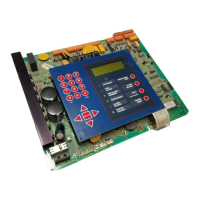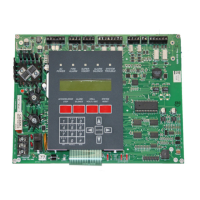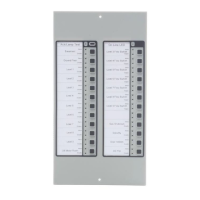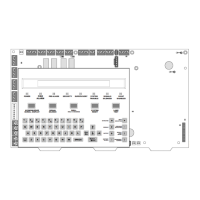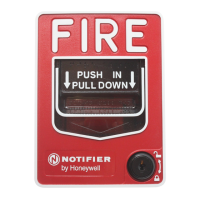Appendices 15088:J 10/22/99
A-6
Table A-2 (Continued)
Type of Circuit Devices/Ratings Circuit Ratings Connections
Common
Telephone Riser
(FFT to XPC or
XP5-C)
FFT-7/FFT-7S Fire Fighter's
Telephone to an XP Transponder XPC-
8 module or an XP5-C Transponder
circuit.
24 VDC (nominal), 1-Vrms max. 800 Hz to 2800 Hz. Seven (7)
telephone handsets active at one time max including Master
Telephone. Supervised/power-limited. Two-wire circuit
supervised via 27K ELR, Part # R-27K (N-ELR for Canada).
Optional return loop for 4-wire circuit. Max wiring resistance
(including individual telephone zone to last handset) permitted is
40 ohms. 10,000 ft. (3048 m) max wiring distance at 12 AWG
(3.25 mm
2
) to last handset.
FFT-7/FFT-7S Connector P3 Term. 3(+) and 2 (-):
to
XPC-8
Connector P3.2 (+), P3.1(-), and/or P4.2
(+) P4.1 (-), P5.2 (+) P5.1(-), P6.2 (+) P6.1(-),
P7.2(+) P7.1(-), P8.2 (+) P8.1(-), P9.2(+) P9.1(-),
P10.2(+) P10.1(-);
to
XP5-C
,TB1-TB5, EXT-, EXT+ or J1A-J5A.
Optional four-wire redundant return to FFT-7/FFT-7S
Connector P3 Term. 6(+) and 5(-)
to
XPC-8
Connector P10;
to
XP5-C
,TB1-TB5, EXT-, EXT+ or J1A-J5A.
Individual
Telep h o n e
Notification
Appliance Circuits
(XPC to Telephone
Jacks)
XP Transponder XPC-8 module fed
from an FFT-7/FFT-7S: employs phone
jacks APJ-1 and FPJ; Fireman's
Handset FHS-1; Fireman's Handset
Enclosures FHE-F and FHE-S.
No telephone jack maximum per circuit. Two-wire circuit
supervised via a 47K ELR, Part # R-47K (N-ELR in Canada).
No outboard ELR for four-wire supervised circuit. Max
resistance due to wiring is 40 ohms from FFT-7 to termination of
the telephone circuit. Power limitation is a function of the signal
source employed. Telephone handset ring signal is provided
with this module.
Two-wire circuits (8 telephone circuits on XPC-8
P2): Term 1 (-), 2 (+); 3(-), 4 (+); 5 (-), 6 (+), 7 (-), 8
(+); 9(-), 10 (+); 11 (-), 12 (+); 13 (-), 14 (+); 15 (-),
16 (+).
Four-wire circuits (4 telephone circuits on XPC-8
P2): Term. 1,3
(-), 2,4 (+); 5,7 (-), 6,8 (+); 9,11
(-), 10,12 (+); 13,15 (-), 14,16 (+).
Individual
Telep h o n e
Notification
Appliance Circuits
(XP5-C to
Telephone Jacks)
XP5-C Transponder circuit fed from an
FFT-7/FFT-7S: employs phone jacks
APJ-1 and FPJ; Fireman's Handset
FHS-1; Fireman's Handset Enclosures
FHE-F and FHE-S.
No telephone jack maximum per circuit. Two-wire circuit
supervised via a 47K ELR, Part# R-47K (N-ELR in Canada).
Max resistance due to wiring is 40 ohms from FFT-7 to
termination of the telephone circuit. Power limitation is a function
of the signal source employed. Telephone handset ring signal is
not provided with this module.
Two-wire circuits (5 telephone circuits) on :
TB1-TB5, B-, B+
Low level Audio
Riser
ACT-2 output to AA-30/AA-30E, AA-
100/AA-100E, or AA-120/AA-120E
input.
NFPA Class B circuit, power-limited 3.5 VRMS max., 50 mA
max.. Monitored for integrity at destination (listed amplifier).
Maximum wiring distance 200 ft (61 m) at 18 to 12 AWG (0.75
to 3.25 mm
2
) gauge wire. Twisted and shielded wiring
recommended when connecting to more than one amplifier.
ACT-2 pins 3,2, and 1 plug directly into P3.3, P3.2,
and P3.1 respectively of an AA-30/AA-30E, or AA-
120/AA-120E. Additional AA series amplifiers feed
from the first amplifier P3.6 (shield), P3.5, and P3.4
to additional amplifier P3.3, P3.2, and P3.1
respectively.
RM-1/RM-1SA output to AA-30/AA-
30E, AA-100/AA-100E, or AA-120/AA-
120E input.
NFPA Class B circuit, power-limited 3.5 VRMS max., 50 mA
max.. Monitored for integrity at destination (listed amplifier).
Maximum wiring resistance from AMG or ACT-2 low-level source
connected at input of RM-1/RM-1SA to farthest AA series
amplifier at output of RM-1/RM1-SA is 40 ohms. Twisted and
shielded wiring recommended when connecting output to more
than one amplifier.
RM-1/RM-1SA TB5 shield out, TB5 - out, and TB5 +
out to AA series amplifier P3.3, P3.2, and P3.1
respectively or another RM-1/RM-1SA on TB4 shield
in, - in, and + in respectively.
AMG-1/E output to AA-30/AA-30E,
AA-100/AA-100E, AA-120/AA-120E,
ACT-1 or RM-1/RM-1SA input
Power-limited/supervised, 40 ohm maximum resistance. 10,000
feet (3048 m) maximum distance at 12 AWG (3.25 mm
2
) gauge
wire. Twisted and shielded wiring recommended. Connect
shield to REF A audio source.
Internal two-wire: AMG-1 P5 to AA Series Amplifier
P2. External two-wire: AMG-1 P4, Terminals 4 (-)
and 5 (+) to AA Series Amplifier P3, Terminals 4 (-)
and 5 (+). External four-wire connection: include
return from AA-30 P8, Terminals 5 (-) and 6 (+) to
AMG-1 P4, Terminals 1 (-) and 2 (+).
Connect AMG-1 P4 terminals 4 (-) and 5(+) to ACT-
2 AUDIO IN terminals (not polarity sensitive).
Connect AMG-1 P4 Terminals 4(-) and 5(+) to RM-
1/RM-1SA TB4 "IN" terminals (not polarity sensitive)
Use of twisted shielded cable is recommended.
High level Audio
Riser
AA-30/AA-30E output to ACT-2 input
Power-limited, 25VRMS, 30 W max., frequency response 800 Hz
to 2800 Hz, two-wire circuit must be monitored for integrity at
destination equipment (listed amplifiers), four-wire circuit is
monitored for integrity at AA-30/AA-30E, 40 ohm maximum wire
resistance.
Two-wire: AA-30/AA-30E P8, Terminals 6 and 5 to
ACT-2 "Audio In" terminals (not polarity sensitive).
AA-30/AA-30E Terminal 4 (shield) to ACT-2 "S".
Optional 4-wire return: ACT-2 "Thru" terminals to
AA-30/AA-30E P8, Terminals 3 and 2 (not polarity
sensitive).
Form-C Dry
Contacts
XP Transponder XPP-1; Dual Form-C
Alarm and Trouble Relays
2 amps resistive @ 30 VDC. One amp inductive (0.6 pf) @ 24
VDC. Not supervised. Power limitation is a function of the
signal source applied.
Refer to the XPP-1 in the XP Series Transponder
System Manual.
XP Transponder XPR-8: Eight Form-C
relays or four Dual Form-C relays.
2 amps resistive @ 30 VDC. One amp inductive (0.6 pf) @ 24
VDC. Not supervised. Power limitation is a function of the
signal source applied.
Refer to the XPR-8 in the XP Series Transponder
System Manual.
CMX-1: One Form-C relay
2 amps resistive @ 30 VDC. One amp inductive (0.6 pf) @ 30
VDC.
Power: Term 2 (+), Term 1 (-) Normally Open
contacts use Term 4; normally closed contact use
Term 5: common use Term 6. Break tabs for Form-C
relay.
CMX-2: One Form-C relay
2 amps resistive @ 30 VDC. One amp inductive (0.6 pf) @ 30
VDC. Pilot duty: 0.6 amps @ 30 VDC (0.35pf); 0.3 amps @
110 VDC (0.35 pf);0.3 amps @ 120 VAC (0.365 pf).
Power: Term 2 (+), Term 1 (-) Normally Open
contacts use Term 4; normally closed contact use
Term 5: common use Term 6. Break tabs for Form-C
relay.
XP5-C Transponder: 5 Form-C relays
3 A @ 30 VDC, resistive, non-coded. 2 A @ 30 VDC, resistive,
coded. 0.9 A, 110 VDC, resistive, non-coded. 0.9 A, 125 VAC,
resistive, non-coded. 0.5 A, 30 VDC, inductive (L/R=5ms),
coded. 1.0 A, 30 VDC, inductive (L/R=2ms), coded. 0.5A, 125
VAC, inductive (PF=.35), non-coded.
TB1-TB5, com, N/O, N/C.
www.PDF-Zoo.com
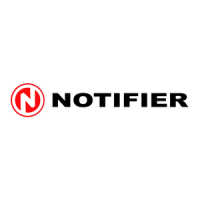
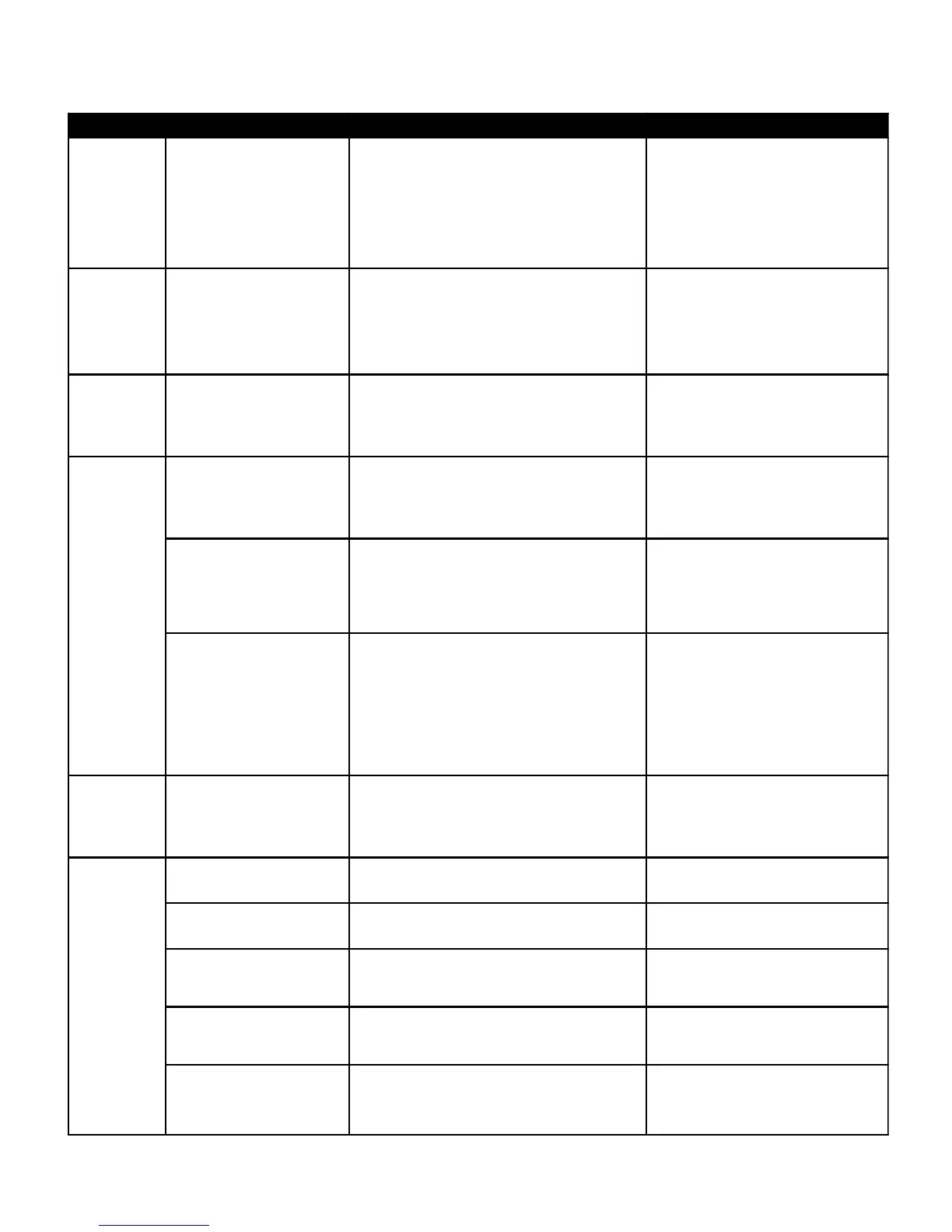